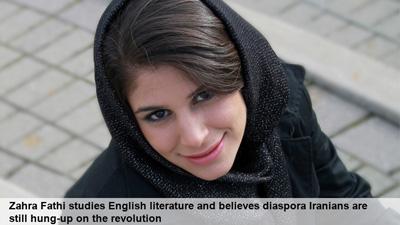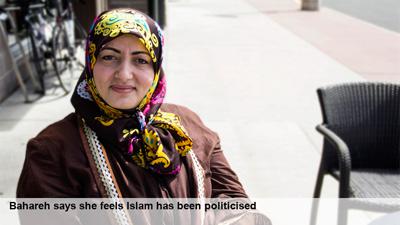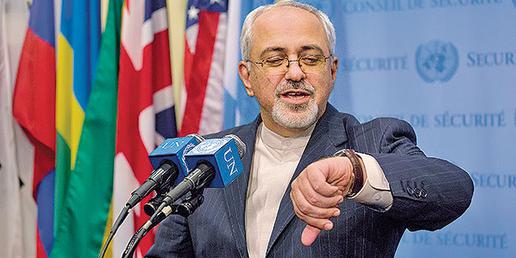
Zahra Fathi sits at a café in her hometown of Toronto on a warm summer weekend afternoon, sipping tea as she reads, her hands occasionally tugging the edges of her colourful headscarf. Fathi began wearing the hejab when she turned nine, a personal choice she says she was enthusiastic about even as a young girl.
But living as a veiled woman in Canada, where she emigrated with her family from Tehran in 1998, isn't always easy. Often people question her decision to wear the hejab and approach her with hostile, judgmental comments. But it isn't white Canadians who respond to Fathi in this way, but Iranians from within her own community. Being a veiled Muslim women in the West can be tough, but being a veiled Iranian woman in the diaspora comes with challenges all its own.
Fathi, 24, is studying English literature at university, and says the majority of Iranians she encounters are prejudiced against her before she opens her mouth. “They don’t see us as agents of our own actions. For many Iranians outside of Iran, my identity as a veiled Muslim woman contradicts the very idea of democracy and liberation,” she says. “I’ve gotten everything from ‘you won’t find a husband’ to ‘does your dad make you wear it?’”
The Hejab, Politicized Even in Toronto
Because veiling in Iran is compulsory, the wearing of hejab is not simply a matter of faith. But that politicization follows women to the Toronto diaspora, where many recent immigrants from Iran carry with them the political associations and tensions that arise from the Islamic Republic's compulsory policies. For Iranian women in the diaspora who have chosen to veil out of individual choice, it is a source of great distress that in the relative freedom of Toronto they must deal with scorn and backlash on a daily basis, from within their own community.
Mateen Rokhsefat, a doctoral candidate in the department of Near and Middle Eastern Civilizations at the University of Toronto, believes that Iranians have a very different and mostly negative attitude from other diaspora Muslims toward veiling, due to the official enforcement of the hejab in Iran. “Iranian hejabis and their families are mostly associated with and accused of having ties with the Iranian government,” she says.
At core, Rokhsefat says, the anger isn't directed to the veiled women themselves, but the political regime they represent. “One can understand the anger of those Iranians who do not wish to observe Islamic practices,” she says. “They therefore project that resentment and anger onto religiously observant Iranians who remind them of the Islamic government.”
Veiling in Iran, especially during the twentieth century, has been at the center of national debates over modernisation, ties with the West, and the role of religion in daily life. Iran banned the hejab in 1936, the first Muslim country to do so, lifted that ban in 1941, and then made veiling mandatory in 1980, when the Islamists consolidated power after the 1979 revolution. Fast-forward 34 years, and Iran remains to be one of the only countries in the world where the hijab is compulsory.
Despite the fact that her decision to veil is not political in any way, Fathi says most Iranians she comes across make aggressive and unsympathetic remarks.
Customers at her workplace, a jewelry store, regularly approach and interrogate her as to why she wears the hejab. She sees these attitudes as reflecting the diaspora's undemocratic culture, and Iranian emigrants' inability to get over the revolution.
“They see me as a by-product of and reminder of the failures of the revolution,” she says. “But they’re no different from those who force others to wear the hijab. They’re just on the other end of the spectrum, both equally problematic.”
A ‘shared female problem’
Due to the compulsory aspect of the hijab in Iran, many Iranians who leave Iran find the actions of veiled Iranian women obscure and backwards. These assumptions derive from common stereotypes, the notions that veiled women are forced by families to veil or that they lack individual spirit.
Unfortunately, inflicting stereotypes are more common amongst Iranian women, Fathi says, because they feel as if it’s a “shared female problem”, which allows them to speak more openly about it. “Looking at Iran’s history, the women’s body has been subjected to the political situation of its time,” she explains.
Although the revolution was unique because of the active involvement of women who deliberately chose to observe the hijab as an attempt to protest against the Pahlavi regime, after the hijab became compulsory, thousands of women from all walks of life attended demonstrations protesting the policies of the very government they had helped bring into power.
Sadly, much of the unity that existed amongst women during those times has evaporrated today, and women themselves have become a “contributing factor”, says Fathi.
Embracing the Hejab

One day, in the fraught years that followed Sept. 11, Bahareh Saiiar decided to start wearing the veil. She was 29-years-old and working in the financial district of downtown Toronto as a systems engineer on the day she walked into work wearing a headscarf.
As the only female in a male dominated industry, and at a time when stark generalizations and damaging stereotypes surrounding Islam and Muslims were common, she had decided to take a leap of faith.
Born in Tehran to a semi-religious family amongst whom veiling was not common, Saiiar emmigrated to Canada at 19. As a young adult Saiiar, who was not religious previously, began adopting the teachings of Islam and incorporating it slowly into her personal and professional life. “I wanted people to respect me for who I am, how I think and what I have to contribute, not the way I look. Society doesn’t dictate how I’m supposed to be, I dictate how I’m supposed to be,” she says.
Saiiar describes wearing the hijab as the major challenge, as it was a concept she understood, but wasn’t comfortable with because it changed her image in the eyes of society. With time, she says she grew to understand the hejab's meaning and began to develop her missing confidence. “How you portray yourself determines people’s reactions towards you,” she says. “You have to find purpose behind everything that you do,” she explains.
For her part, Saiiar hasn’t received many negative reactions from Iranians, because the way she wears her scarf is not reflective of the way Iranians usually wear it. Her fluent English and professional mannerism usually means she gets looks of respect, but at times she also receives looks of curiosity and puzzlement. “A main challenge with the Iranian community is the political background, and the things that are done in the name of Islam that are not Islam,” Saiiar says.
She recalls an incident when she entered the room and an Iranian woman made a comment associating her with Iranian politics. Her approach to these types of remarks is to smile and respectfully clear up misunderstandings. “I tried in 15 minutes to explain what Islam teaches, what is happening in reality, how I feel about it, and that she can’t associate every single Muslim with what’s happening in the political world,” she says.
Saiiar believes that hejab is necessary for faithful Muslim women, but she says she does not believe in enforcing that by law.
According to Dr. Soroush Dabbagh, a philosopher and scholar of Islam and a visiting professor at the University of Toronto, “compulsory hijab undermines the whole idea of autonomy and freedom of choice. The idea of human dignity and autonomy requires us to make room and pave the way for every human being to act according to his/her own choice and attitude,” he says.
As a result of compulsory hejab in Iran, many Iranians base their information and knowledge of Islam and the hejab on politics, rather than what the religion actually teaches, Saiiar says.
Once Stung, Forever Wary
Many Iranians are still dealing with the painful aftermath of the revolution, and this tense emotional backdrop makes it even more urgent for Iranian Muslim women to play a role in reversing prejudice by creating dialogue and discussion.
Maral Adhami, an Iranian biomedical engineering student, says she thinks it's key to sympathize with those who react negatively towards the hejab because she understands why they act the way they do. People who make comments are usually ones who have left Iran recently, Adhami says, which means that their perspectives and lifestyles greatly differ from those who have grown up in North America. They may be more prone to judge quickly based only on appearances. “We judge people immediately based on the car they drive, the house they live in, and the education they have,” Adhami says of the Iranian culture.
Growing up in Canada on the other hand makes you less judgmental of others. Multiculturalism is a concept so fully embedded in Toronto that it is seen as rude and problematic to question others for how they dress. Instead, tolerance and respect are concepts that should be extended to each and every individual.
Adhami was born in New Zealand to Iranian parents and grew up in Toronto. Although at times it might seem like a big responsibility, she believes that Muslim women can be influential in helping alter the perception of those who misunderstand the religion and the hejab. “You have the power to change people’s outlook,” she says.
For Some, Hejab is Liberation
The women I spoke with for this piece all said that they don't feel limited by the hejab, and that veiling does not limit those who don’t allow it to. A lover of soccer, Adhami has been playing since a young age as the only female on her team who wears the headscarf. She says that people become much more respectful and accepting when Muslim women integrate themselves into society, rather than isolating themselves.
The perception of Muslim women as oppressed, rigid and one-dimensional is gradually decreasing because of the emergence of women who are entering societies where Muslim women were not seen before. This is contributing to much-needed progress both in the Muslim world as well as amongst Iranians.
In March of this past year, the winner of an Iranian singing competition called ‘Googoosh Academy,’ held in London, was a veiled 31-year-old woman named Ermia. There was a mixed response from within the Iranian community, who debated the win hotly on social media; some felt proud and applauded her achievement, others immediately linked her success to the Islamic regime, and conservatives accused her of tarnishing Islam.
For Ermia herself, we can only assume there was no contradiction between singing and the hejab she wore. That many in the diaspora felt angered by her win reflects the simmering resentments that women like Fathi have experienced. But in order for the diaspora to develop a more tolerant, inclusive culture, such moments offer an opportunity to debate the very meaning of individual choice. Such dialogue is crucial to disrupting the ways Iranian governments of past and present have defined Islam and the ways women fit into it.
Hanieh Khosroshahi is a Toronto-based writer and photographer interested in international affairs and issues surrounding the Middle East.
visit the accountability section
In this section of Iran Wire, you can contact the officials and launch your campaign for various problems






















comments